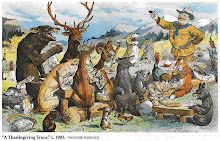An intriguing study of mule deer and whitetail deer conducted by the University of Alberta in Edmonton, Canada and the University of Lethbridge, also in Canada, showed that both species responded to the recorded distress calls of fawns, similar to the responses elicited when coyotes attack fawns, with mule deer mothers responding to both whitetail and mule deer calls, even when their own fawn stood next to them. In contrast, the whitetail mothers responded only to their own species' call, and only when they could not see their own fawn.
"The fact that mule deer ran to the speaker when their own fawn was standing next to them safe and sound revealed they do not help other fawns because they mistake them for their own," said lead author Susan Lingle, who conducted the research as a postdoctoral fellow in biological sciences at the University of Alberta and in psychology at the University of Lethbridge. "It was surprising just how indiscriminate mule deer females were. For example, the females that weren't even mothers also ran to the speakers to help fawns. That would not be expected if females were simply trying to protect their own fawns."
In field trials using speakers that broadcast the calls of fawns under threat, the mule deer came to the speaker and stayed there as long as the calls played, twisting and turning as they confronted the perceived attackers. Whitetail mothers that came close to the speaker tended to withdraw right away and then stayed safely outside that distance.
The behaviour of mule deer defies traditional explanations that parental care, kin selection or reciprocity play a part in the defence of fawns other than their own. But while the study's findings seem to point to mule deer as superior mothers, the motivation for looking out for other fawns is likely based not on altruism but on simple survival, said Lingle."Having a rigid and aggressive response to the simple sound of a fawn distress call may ensure effective defence of a female's own offspring, even though this means the female invests time and energy and puts herself at risk by helping many other animals. In contrast, a whitetail mother waits to assess whether a fawn is her own before she steps in to defend it. As a result, whitetail fawns suffer considerably more predation during the first months of life than do mule deer fawns."
Mule deer may have developed a more effective aggressive defence because they rely on fighting to protect themselves against predators year-round, while whitetails and many other species restrict aggressive defence to just the youngest fawns. Whitetails rely on flight rather than fight for most of their lives, so this may affect their ability to mount an aggressive defence," Lingle said.
The results appear in this month's issue of Animal Behaviour. This project was funded in part by the Alberta Ingenuity Fund and the Natural Science Engineering and Research Council of Canada.
"The fact that mule deer ran to the speaker when their own fawn was standing next to them safe and sound revealed they do not help other fawns because they mistake them for their own," said lead author Susan Lingle, who conducted the research as a postdoctoral fellow in biological sciences at the University of Alberta and in psychology at the University of Lethbridge. "It was surprising just how indiscriminate mule deer females were. For example, the females that weren't even mothers also ran to the speakers to help fawns. That would not be expected if females were simply trying to protect their own fawns."
In field trials using speakers that broadcast the calls of fawns under threat, the mule deer came to the speaker and stayed there as long as the calls played, twisting and turning as they confronted the perceived attackers. Whitetail mothers that came close to the speaker tended to withdraw right away and then stayed safely outside that distance.
The behaviour of mule deer defies traditional explanations that parental care, kin selection or reciprocity play a part in the defence of fawns other than their own. But while the study's findings seem to point to mule deer as superior mothers, the motivation for looking out for other fawns is likely based not on altruism but on simple survival, said Lingle."Having a rigid and aggressive response to the simple sound of a fawn distress call may ensure effective defence of a female's own offspring, even though this means the female invests time and energy and puts herself at risk by helping many other animals. In contrast, a whitetail mother waits to assess whether a fawn is her own before she steps in to defend it. As a result, whitetail fawns suffer considerably more predation during the first months of life than do mule deer fawns."
Mule deer may have developed a more effective aggressive defence because they rely on fighting to protect themselves against predators year-round, while whitetails and many other species restrict aggressive defence to just the youngest fawns. Whitetails rely on flight rather than fight for most of their lives, so this may affect their ability to mount an aggressive defence," Lingle said.
The results appear in this month's issue of Animal Behaviour. This project was funded in part by the Alberta Ingenuity Fund and the Natural Science Engineering and Research Council of Canada.










No comments:
Post a Comment